Some Possible New Year's Resolutions for the Cellular Industry
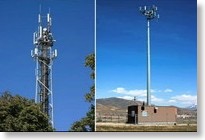
As we approach the New Year, here are some constructive suggestions for the cellular industry to think about as New Year’s resolutions. Long time readers will recognize that many have been discussed before in other contexts. Let me state first that I am a long time admirer of the cellular industry, its dynamic growth, and its general record of technical innovation. The cellular industry has also done much to improve public safety through its support for E-911, Amber Alerts, and programs to provide cell phones for domestic violence victims. But this industry has several blind spots as it has accumulated political power and FCC influence comparable to the power formerly held by entities such as the pre-divestiture AT&T, NAB, or the pre-1990 Motorola. sic transit gloria mundi
The purpose of this post is to point out constructively some of these blind spots that appear not to be in basic conflict with the fundamental goals of the industry in the hope that they may reconsider their positions in at least some of these areas. I note that while the main cellular players once were in strong opposition to the bidirectional amplifier/BDA issues now in Docket 10-4, they have moderated their position and appear to be working with responsible BDA manufacturers on technical standards for BDAs that control interference. I hope that similar reexamination is possible in the areas below:
1. Wireless technology innovation. The focus of the cellular industry is that innovation is good, but that the key to innovation is more licensed spectrum for their industry. They are happy with the current level of regulation so everyone should be also. This is clear from CTIA’s comments and reply comments in the Wireless Innovation NOI. They see no need to expedite deliberations of new technology, saying “Simply put, even for good ideas with broad appeal, resolution unfortunately can take a long time notwithstanding the desire of parties to speed the process along”. The fact that the endless drawn out FCC spectrum deliberations stifle capital formation for technical innovators is no concern for mainstream CMRS players with positive cash flow.
But Qualcomm was once a startup in an era when it got its key regulatory decision in 2 years after formation. The CDMA technology that this startup pioneered supplies a major fraction of the 2G market (VZW and Sprint) and is the core of all world’s 3G systems. But this type of disruptive wireless innovation os getting to be impossible due to regulatory stagnation but for the cellular industry and for other spectrum users that compete for cross elastic spectrum. Sadly, the cellular industry is firm with the status quo here.
Wa - harmony (Japanese)

What is the industry doing about this? Are they trying to increase sidetone levels so people don’t shout when using cell phones? Are they trying to make it easier to switch the ringer to a vibrate only/ “manners mode” as in Japan where all carriers have voluntarily agreed that a press of the “#” key toggles the unit to and from vibrate only mode? Are they researching ways for theaters and restaurants where people really want a semblance of quiet to use Bluetooth or a similar link to switch phones automatically to vibrate only? Kudos to Motorola for inviting Dr. Norman to talk on this issue. How much of this type of dialogue is going on now in the industry?
UPDATE
Suggested reading for cellular industry managers: “Wild Night at Philharmonic After Phone Interruption” describing a January 10 incident “in one of the quietest parts of the final movement of a gorgeous New York Philharmonic performance of Mahler's Ninth”.
3. Cell phones use in vehicles. Technology should improve life, not threaten it. In September 2011 NTSB recommended a ban on cell phone use in commercial vehicles (trucks and buses) after investigation of a Kentucky crash that killed 11 people. The industry was silent except for an e-mail message to your blogger saying “The wireless industry … does not oppose legislation that restricts the use of wireless communication by drivers." (This quote was never printed or posted anywhere else as far as can be determined.)
Then in December 2011 NTSB recommended to “ban the nonemergency use of portable electronic devices (other than those designed to support the driving task) for all drivers”. This time CTIA was no longer silent, saying “ As far as talking on wireless devices while driving, we defer to state and local lawmakers and their constituents as to what they believe are the most appropriate laws where they live.” This is not leadership, this is non opposition. If I was involved in a product or service that resulted in death on a regular basis as an unintended byproduct I would be a lot more concerned. Especially since talking in cars is not the main use of cell phones.
The NTSB recommendations are not perfect. For example they do not deal with new technology since all NTSB can do is investigate past accidents. Why doesn’t the industry do something more proactive like start a standards committee, or encourage DOT to start one, that can certify which technologies are safe enough for use in vehicles?
(But kudos to Sprint for breaking with the crowd and being a cosponsor of Oprah’s Oprah’s No Phone Zone website and its “No Phone Zone Pledge”.)
4. RF safety. Most of the cellular industry thinks that the public should be happy with their statements that cellphones meet FCC standards and are therefore safe. A decade ago, the industry fought FCC over the proposal to stop hiding SAR ratings for cell phone models in an obscure unmanageable database. As a previous blog post here has as a headline, “CTIA: Maybe Your RF Safety PR Strategy Isn't Working?” The past year has seen CTIA boycott San Francisco and got to court (with an initial partial victory) over a local ordinance requiring point of sale disclosure of SAR data. (The same data that Verizon Wireless openly discloses on their website for models they sell.)
Perhaps the industry does not want you to know about the secret of OETB65C. Stalin once said, “The people who cast the votes decide nothing. The people who count the votes decide everything.” So the SAR standards for cellphones in Sections 2.1091 and 2.1093 were subject to a notice and comment rulemaking that made 1.6 W/kg the SAR limit. But how is that really determined? In practice through the procedures of OETB65C which gives the manufacturers a lot of leeway as to what spacing from the simulated body they can use for measurements in the body, even if they do not provide a holder that would implement that distance and even if they don’t warn users not to put the device in their pocket. Both Time magazine and your blogger have written about this issue, but there seems denial at both FCC and industry on the issue.
There is no proof that cell phone radiation is dangerous. Indeed, some of the brain cancer claims made as clearly outrageous. (Considering there is no proof that cell phone radiation causes any pathology, why the focus on brain cancer - except that it is a very scary diagnosis.) But the web site of CTIA’s French counterpart is a lot more pragmatic than US industry sites on the risks and unknowns as well as the fact that some users may want to take extra precautions. The Swiss counterpart of EPA also has a site with pragmatic and practical information lacking in industry and government sites in the US.
5. Base stations and their environments. One of the issues driving the need for more CMRS spectrum is the difficulty of building base stations, particularly in suburban areas. Cellular capacity is a function of 3 factors: technology (e.g. 3G vs. 4G), infrastructure (number and nature of base stations, and amount of spectrum. Limits on one factor press demand on the others. For 2 decades industry has pressed Congress and FCC to limit the ability of local governments to control base station deployments with limited success. The reason is simple for the limited progress; as Tip O’Neill said famously, “All politics is local”. As long as base station designs “look like they are designed by engineers” with no regards for their surroundings in most cases, the neighbors will object.
This month’s IEEE Spectrum reports on a UK design contest for power pylons sponsored by a major electric utility, a national government agency, and the architect’s professional society, which resulted in several novel designs including the one above. Why can’t the US cellular industry help sponsor a similar contest for bold new ideas in base station design? The cost would be small compared to what they are spending on they lobbying war with the broadcasters as present.
6. “Spectrum scoring” or “How to count to 500”. The cellular industry originally demanded 800 MHz of new spectrum for CMRS although they are now accepting of the 500MHz NBP goal. But what spectrum counts towards the 500 MHz goal? Does every single Hertz have to be only in spectrum that meets standards developed in Europe to be manufactured in China? There are many types of wireless innovation other than making iPhone and iPad clones. Some of them involve using spectrum more efficiently. The focus on meeting international standards means that only innovators who want to plow through the complex international standards process can get market access in the US. Actions like PacTel’s decision to go with CDMA in the 1980s apparently is beyond consideration now.
While your blogger has no views against giving more spectrum to CMRS, many of us think the 500 MHz goal is impossible under the conditions for “counting” that the cellular industry has implicitly set with factors like nationwide 24/7 1000 ms/s access and in 3GPP specified bands. Although LTE systems can use unpaired spectrum, most of the spectrum on their wish list appears to be paired and symmetric. If FCC and NTIA come up with spectrum that doesn’t that meets all these criteria, does it “count”?
7. Provide communications for niche applications that otherwise contend for spectrum with CMRS. After the success of the iPhone, the CMRS focus seems to be on “killer apps”/knock out new products. Niche markets are of little or now interest unless they can be served with apps on standard hardware. Who needs little $100M markets. This is understandable from the MBA viewpoint.
But here is another viewpoint: Some niche markets compete for spectrum at FCC that is the same or comparable spectrum to what the cellular industry seeks. For example the medical community is clearly seeking more spectrum for short range applications. It is clear to many of us, even some in FCC, that the existing use of wireless microphones in UHF TV band “white space” is not sustainable in the long term except perhaps for uses involving only a few microphones like small churches and conference rooms - not theaters and major concerts. This is because of cellular industry pressure for UHF incentives auctions that will eventually tie up the same spectrum.
In the past, there was no alternative for the CMRS industry to serve these and other wireless niches. However, with the spectrum leasing provisions of Subpart X of Part 1 and today’s femtocell technology it is possible for cellular carriers to lease short range spectrum to users with other than standards cellular modulations/physical layers and without connection to the public network. A good example is the Qualcomm FlashLinq™ technology that will allow users to connect directly to each other with non standards modulations on spectrum leased from and under the control of a CMRS carrier. Maybe the specifics of FlashLinq™ are not perfect for the CMRS community, but it clearly shows the feasibility of new types of spectrum use in CMRS spectrum. Even if it is not a billion dollar market, its ability to “soak up” other spectrum uses that would otherwise compete for spectrum might make it attractive to openminded CMRS firms.

Until recently, the largest prepaid operator, TracFone, allowed users to activate a phone bought anonymously and “skip” the step to report name and address. However, the option of buying with cash bagfuls of prepaid phones at Walmart, activating them over the web with a false name and address, and selling them for criminal use is still quite real. Isn’t it odd that we more concerned about over-the-counter sales of Sudafed and Plan B than we are about bagfuls of anonymous cellphones?
Many countries require some identification before prepaid phones can be activated. This is a complex issue both because of the size of the market and the appeal of prepaid phones to market sectors who need them for legitimate economic and safety-related reasons but, as we know from the voter ID controversy, may lack or be unwilling to identify themselves in the standard ways. While I sincerely hope we never have a cellphone-related IED attack in this country, such an event would force a PATRIOT Act-like knee jerk reaction that could be more draconian that a deliberate process now to address the situation.
UPDATE
For those of you who wonder about the temerity of an industry outsider raising such questions about the cellular industry, let me point out the Verizon $2 “payment fee“/“convenience charge” kerfuffle that started just as this blog was first posted and ended a day later. Clearly, VZW, the largest cellular carrier in the US was out of touch with its customers on this issue and had to beat a hasty retreat. Perhaps the industry is also out of touch on the above issues?
UPDATE 2
On 1/7/12 CNN posted an article by bestselling author Bob Greene entitled “Is 2012 the year to hang up the phone?”
Story highlights:
There is growing chorus of officials, employers urging less cell phone useHe says NTSB warns against use in cars; bosses pushing back on personal calls at workHe says cell-phone distractions even affect surgeons and nurses; cut productivityIt may be impossible to take people's freedom of cell use away from them
So your blogger is not the only one seeing cell phone use backlash. Perhaps if the industry was more sensitive to the concerns listed above it might be in their own interest?
TV Whitespace Progress
Today, the Federal Communications Commission issued a Public Notice announcing that the Office of Engineering and Technology (OET) has approved Spectrum Bridge Inc.’s television white spaces database system, which may provide service to devices beginning January 26, 2012. OET has also approved a device by Koos Technical Services, Inc. (KTS) as the first product allowed to operate on an unlicensed basis on unused frequencies in the TV bands. The KTS device will operate in conjunction with the Spectrum Bridge TV band database.
The database announcement says the database approval is effective January 26, 2012. NAB reported some problems during testing and asked for both more testing and another round of comments. FCC rejected the need for more comments but required that the problems identified to date be fixed. However, the initial implementation of the database will be limited to “ to the Wilmington, NC market, specifically to the city of Wilmington and New Hanover County, NC” due to problems with the FCC registration system for nonbroadcaster high density wireless microphone usage sites such as concerts. Your blogger has serious doubts whether the FCC provision for registering these wireless miss will be practical. Time will tell.

Above is the first equipment authorization approval granted to Florida’s Koos Technical Services, a firm that seems to have some partnership with Spectrum Bridge. While the Commission’s Rules do not forbid this type of relationship, one wonders if anyone ever thought about it from the policy viewpoint.
The FCC grant is surprising in that the approved spectrum is not UHF, but rather 177-213 MHz in the upper VHF band. This is the middle of channel 7 to the middle of channel 13. The device’s manual states that “it is designed to provide a reliable wireless connection for digital communication in selected TV bands in the 174 – 216 MHz (VHF) or 470 - 698 MHz (UHF) frequency ranges.” The manual also states the power amplifier “provides up to 1 Watt (30 dBm) of RF output power” - but the approved power limit is 0.1 Watt. The manual states the data rate is “1.5 or 3.1 Mb/s” with a 6 MHz channel bandwidth. Indeed the test reports KTS submitted to FCC repeatedly mention “Transmit power 25 dBm” or 0.316 W, yet the authorized power is 0.1 W. So it is clear that the parameters that were approved are not the ones in the original submittal to FCC.
Perhaps KTS had to back off its intended performance to meet FCC emission limits. Previously, several mainstream manufacturers complained to FCC that they could not meet the out-of-band emission requirements in this band with off-the-shelf equipment designs. However, MSS client Adaptrum demonstrated to FCC in a March 2011 filing that it could comply with the OOBE limits.
Congratulations to Spectrum Bridge and KTS on these first approvals. We hope there will be many more soon.
UPDATE
Andrew Mancone, Director of Sales and Marketing at KTS Wireless posted this clarification to Linkedin’s Spectrum Experts group:
Unfortunately, that paragraph in the December 22nd FCC notice caused a bit of confusion. The project in Wilmington has approval to move forward but our certification is finalized and valid starting January 26th, 2012.
Rumor has it that there are some wireless microphone channel optimization efforts underway and the administrative cleanup will take until the 26th of January. Therefore, the staggered start.
Fear not, certified devices are now here and implementation plans can move forward.
LightSquared/GPS Update

Just in time for the holiday season is an exchange between the two implacable forces in this major spectrum battle.
From LightSquared we have a December 20 Petition for Declaratory Ruling. It contains a detailed history of Commission actions on how we got to where we are. Earlier filings have given much of this, but this one is more comprehensive and many of the milestone seem to be unknown to concerned people in the policy community that I have spoken with. For example
The concept of using MSS spectrum for combined satellite and terrestrial purposes, and LightSquared’s authority to conduct such operations, have evolved with the active participation and support of the commercial GPS industry for almost a decade. Indeed, LightSquared has worked with the commercial GPS industry to ensure that GPS receivers would remain compatible with LightSquared’s forthcoming terrestrial broadband network in the L Band. During this time, the GPS industry repeatedly supported the evolving technical parameters of LightSquared’s network—and, in particular, supported LightSquared in proceedings in which the Commission relaxed the numerical limits applicable to LightSquared’s terrestrial transmitters and significantly increased the power level at which LightSquared’s terrestrial base stations may transmit within its authorized MSS spectrum. (p.5).
Fierce Mobile Content provided a set of quotes from the GPS industry on this filing. For example, Jim Kirkland, Vice President and General Counsel of Trimble is quoted saying,
"This latest filing simply recycles the litany of inaccurate and self-serving claims that LightSquared has made in its ongoing effort to deny its obligation to avoid harmful interference to millions of government and private GPS users.”
Oddly, Margaret Podlich, President of BoatUS, a pleasure boat group your blogger is a member of, said,
"Boat owners take the responsibility for the safety of our family members and friends very seriously. To compromise one of their most important, reliable, and critical pieces of safety equipment, which is the essence of the Light Squared signal interference issue with GPS, is not only foolish, but irresponsible. No margin of safety should be reduced simply because a private corporation sees a new business opportunity."
While there are some complicated issues of aviation safety and impact of MSS band base stations on terrestrial GPS receivers within 100m of a base station, as the owner and user of boating GPS receivers I would have thought that this class of stations had the least issues.
This makes me wonder if the hypothesis of a GPS industry insider I spoke to a while ago is correct. He wondered if the GPS industry players has all made a “suicide pact” and were prepared to “drink the Kool-Aid” if any subset of the industry was impacted in any way.
IEEE-USA to Sponsor Presentation at FCC on Terahertz Technology

IEEE-USA, in cooperation with the Federal Communications Commission's (FCC) Office of Engineering and Technology, is sponsoring a public presentation on "Terahertz Technology: The Next Frontier for Radio," to be held in the FCC Commission Meeting Room (TW-C305), at 10AM on Monday, 19 December 2011. (This assumes that the Federal Government will be operating that day, of course.)
When: 10AM on Monday, 19 December 2011
Where: FCC Commission Meeting Room (TW-C305) (Google Maps)
Recorded video from the event will be available on 21 December at http://techchannel.att.com/showpage.cfm?Conference-TV.
Dr. Michael C. Wanke
Principal Member of Technical Staff, Sandia National Laboratories, and co-author of a survey article on terahertz technology in the September issue of IEEE Spectrum
Dr. Peter Siegel
Senior Research Scientist and Technical Supervisor: Submillimeter Wave Advanced Technology, CalTech Jet Propulsion Laboratory, and Editor-in-Chief of IEEE Transactions on Terahertz Science and Technology
Mr. David M. Britz
AT&T Expert for Free Space Optical Communications and the Terahertz communications initiative, and Principal Member Technical Staff, AT&T Labs Research – Shannon Labs
UPDATE
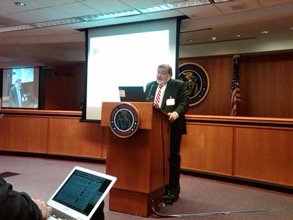
Mr. David Britz of AT&T Labs Research speaking at the
IEEE-USA briefing to FCC on terahertz technology
19 December 2011
Presentations are on IEEE-USA website
Recorded video from the event will be available on 21 December at
http://techchannel.att.com/showpage.cfm?Conference-TV.
"No call. No text. No update. Is worth a human life" -- NTSB Chmn. Hersman

“According to [the National Highway Traffic Safety Administration], more than 3,000 people lost their lives last year in distraction-related accidents,”she said. “It is time for all of us to stand up for safety by turning off electronic devices when driving.”
The NTSB’s recommendations urge all 50 states and the District ”to ban the nonemergency use of portable electronic devices (other tha
n those designed to support the driving task).”
Here is the recommendation from the NTSB site:
To the 50 states and the District of Columbia:
(1) Ban the nonemergency use of portable electronic devices (other than those designed to support the driving task) for all drivers; (2) use the National Highway Traffic Safety Administration model of high visibility enforcement to support these bans; and (3) implement targeted communication campaigns to inform motorists of the new law and enforcement, and to warn them of the dangers associated with the nonemergency use of portable electronic devices while driving
Readers are reminded of a previous post here entitled “CTIA Mum on NTSB Cellphone in Truck Recommendation”. Shortly after that post
we heard from CTIA:
Actually, we did have a statement. Here is a statement to attribute to John Walls, vice president of public affairs for CTIA--The Wireless Association:
"Accidents that involve any of the numerous driving distractions are unfortunate, and those resulting in loss of life are tragic. The wireless industry has been educating drivers about the dangers of distracted driving for more than a decade, and does not oppose legislation that restricts the use of wireless communication by drivers."
At the time of the blog post a search of the CTIA website for "NTSB" gave no hits at all. It still gives no hits.
Mr. Walls' quote is not available on either the CTIA blog or under press releases. Indeed, a search for the words in the statement had not hits on the CTIA site strongly implying it was not publicly available.
So we welcome this statement that the industry "does not oppose legislation that restricts the use of wireless communication by drivers". However the current CTIA position statement on safe driving does not have Mr. Walls’ general concept of nonopposition to driver restrictions - it only deals with manual texting and “younger drivers”. Let’s hope that CTIA continues to move away from opposing safety-related restrictions and even actually supports the new NTSB recommendation.
CTIA’s Steve Largent issued the following statement:
“CTIA and the wireless industry agree that when drivers are behind the wheel, safety should be their number one priority. Manual texting while driving is clearly incompatible with safety, which is why we have historically supported a ban on texting while driving. As far as talking on wireless devices while driving, we defer to state and local lawmakers and their constituents as to what they believe are the most appropriate laws where they live.
“The wireless industry remains focused on educating consumers about their responsibilities when they’re driving, especially inexperienced drivers. We’re proud of our partnership with the National Safety Council that focuses on teens and novice drivers that tells them ‘On the Road, Off the Phone.’ As part of the partnership, we developed a TV and two radio public service announcements (PSAs) that have been viewed and heard by millions.
“In regards to NTSB’s recommendation number 12, we have always encouraged the industry to continue to develop new technology-based tools and offerings that are affordable and consumer-friendly that would create safer driving. The industry constantly produces new products and services, including those that can disable the driver’s mobile device.
“We remain dedicated to educating all consumers to ensure when they are behind the wheel, safety is their top priority.”
This is the first time CTIA has ever mentioned NTSB on their website.
Statements of NTSB Chairman Deborah A.P. Hersman
Opening Statement December 13, 2011 Highway Accident Report: Multi-Vehicle Collision Gray Summit, Missouri, August 5, 2010
Closing Statement
Washington Post op-ed “Why we should ban drivers from using portable electronic devices” 12/16/11
FCC ex parte enforcement: No More "Professional Courtesy"
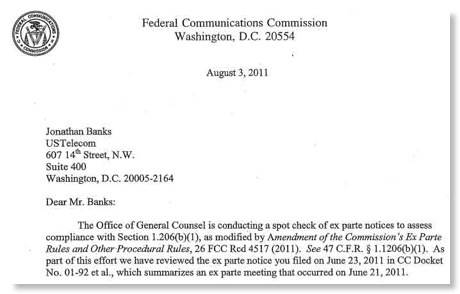
ex part enforcement at FCC, or lack thereof, has been a recurring topic here. We now have 3 basic eras of FCC practice in FCC enforcement of its ex parte rules.
1978 - January 2011
“Professional courtesy” combined with “holding telescope to the blind eye” approach. During this 33 year period FCC did not have a single written record of finding an ex parte violation. There is anecdotal evidence that some ex parte complaints were resolved with phone calls to violators and verbal warnings but no written public records exist. Naturally, some entities with little interest in transparency noticed this and saw it as a blank check to do whatever they wanted.January 11, 2011 - August 3, 2011
FCC starts more aggressive review of complaints with its 1/11/11 finding that Magnum Communications was guilty of a violation - the first EVER written finding of a violation.August 3, 2011 ->
FCC announces 3 findings of violations based on “a spot check of ex parte notices to assess compliance”. In this new era FCC not only finds violations but does not depend solely on complaints.
Imagine the surprise on August 3, 2011 when USTelecom, Public Utility Commission of Texas, and Parrino Strategic Consulting Group received similar letters saying based on a spot check they had been found to violate Section 1.1206(b)(1). Now there was no penalty or even a warning or probation, but they were told “Accordingly, we ask that you file a supplemental notice that complies with the rule within one week.”
As another sign of assertiveness, one July 28, 2011 FCC found that Christian Media, Inc. “violated the Commission’s ex parte rules by soliciting impermissible ex part letters from members of Congress in violation of 47 C.F.R. § §1.1208 and1.1210” and referred the matter to the Enforcement Bureau “to determine whether a forfeiture is warranted”. As stated previously, your blogger doubts that Title V of the Communications Act permits fines in the case of such violations. So my unsolicited “free legal advice” to Christian Media, Inc. is: don’t start liquidating assets now to pay for a possible fine.
But kudos to FCC/OGC for these major changes in ex part enforcement that will either increase compliance OR lead to the realization that there is a good reason why every other federal agency uses a different approach in dealing with ex parte presentations.
H.R. 3010 and its Likely Impact on Wireless Innovation
“The current regulatory system has become a barrier to economic growth and job creation. Federal regulations cost our economy $1.75 trillion each year. Employers are rightly concerned about the costs these regulations will impose on their businesses. So they stop hiring, stop spending and start saving for a bill from Big Brother. But rather than burdening businesses with more regulations, we need to free up employers so they can create jobs for American workers. The Regulatory Accountability Act does just that. It places permanent restrictions on regulatory agencies and restores accountability by requiring openness and transparency in the regulatory process. This is a bipartisan, bicameral bill that both parties, both houses of Congress and the President should support.”
The CRS summary of RAA states,
“Regulatory Accountability Act of 2011 - Amends the Administrative Procedure Act to revise and expand the requirements for federal agency rulemaking by requiring agencies, in making a rule, to base all preliminary and final determinations on evidence and to consider the legal authority under which the rule may be proposed, the specific nature and significance of the problem the agency may address with the rule, any reasonable alternatives for the rule, and the potential costs and benefits associated with such alternatives.
Requires agencies to publish advance notice of proposed rulemaking for major rules and for high-impact rules (rules having an annual cost on the economy of $100 million or $1 billion or more, respectively), which shall include a written statement identifying the nature and significance of the problem the agency may address with a rule, the legal authority under which the rule may be proposed, and a solicitation for written data and comments from interested persons.
Sets forth criteria for issuing major guidance (agency guidance that is likely to lead to an annual cost on the economy of $100 million or more, a major increase in cost or prices, or significant adverse effects on competition, employment, investment, productivity, innovation, or ability to compete).
Expands the scope of judicial review of agency rulemaking by allowing immediate review of rulemaking not in compliance with notice requirements and establishing a substantial evidence standard for affirming agency rulemaking decisions.
Thus the basic presumption of RAA is that ALL federal regulations add new burdens on industry and that Congress needs to make a major change to the 1946 Administrative Procedures Act to slow new regulations. While this is certainly true for many regulations from many agencies and also the reason why EPA is called by some the “employment prevention agency”, new FCC Title III technical regulations almost always have the impact of allowing for the first time new technologies and new products and contributing to economic growth and national competitiveness.
RAA would subject FCC to the provisions of Clinton-era EO 12866 including OMB review of new rules. It would also expands the grounds for judicial review - another sure way to slow down innovation.
In the Wireless Innovation NOI, the speed of FCC deliberations was raised as an impediment to technical innovation and the capital formation that it needs. Mitchell Lazarus, a well known lawyer who often is involved in innovative wireless technologies stated in his personal comments,
“The Commission's Rules are based largely on the technologies in place when they were written. New radio-based technologies often fail to satisfy those rules. The more novel an innovation, the less likely it is to comply. In consequence, a new wireless technology may need a Commission rulemaking or a waiver before it can reach the market. Technical proceedings in general, including those to authorize new technologies, have been dismayingly slow”
Lazarus ends with the recommendation that to speed wireless innovation FCC should have an exemption from the Administrative Procedures Act burdens that have accumulation in 65 years of case law and only be bound by the original statutory provisions. The RAA is above in the opposite direction and may well worsen the existing gridlock on innovative technology. Perhaps the provisions of RAA would be helpful at most other agencies and maybe even in much of FCC’s jurisdiction. But their application to technical Title III rule makings at FCC could have a disastrous implication for technical innovation and national competitiveness.
Of course, broadcast and cellular incumbents are the “haves” today and might welcome a slowdown in technical innovation that might encroach on their spectrum. Readers who think this might be reasonable are encouraged to read the previous blog entry about Ofcom’s CEO’s views on innovation and its impact.
But to say something good about RAA, § 553(f)(2) has the following provision that could help consideration of technical issues at FCC:‘‘The agency shall adopt a rule only on the basis of the best reasonably obtainable scientific, technical, economic, and other evidence and information concerning the need for, consequences of, and alternatives to the rule.” Of course, NTIA is subject to similar terms under existing Executive Branch policy on scientific integrity and it is not clear if they have had much impact there.
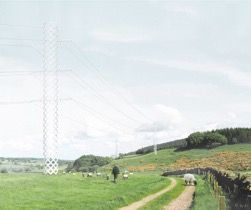
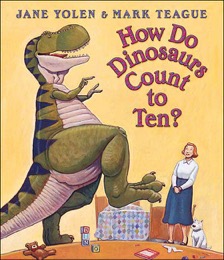

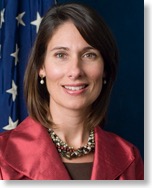
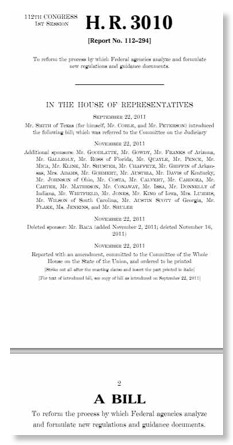


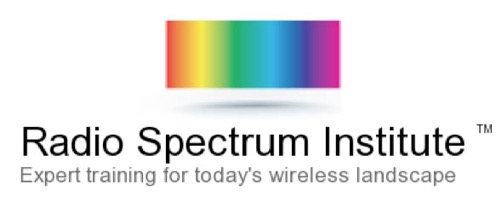


![Validate my RSS feed [Valid RSS]](valid-rss-rogers.png)

